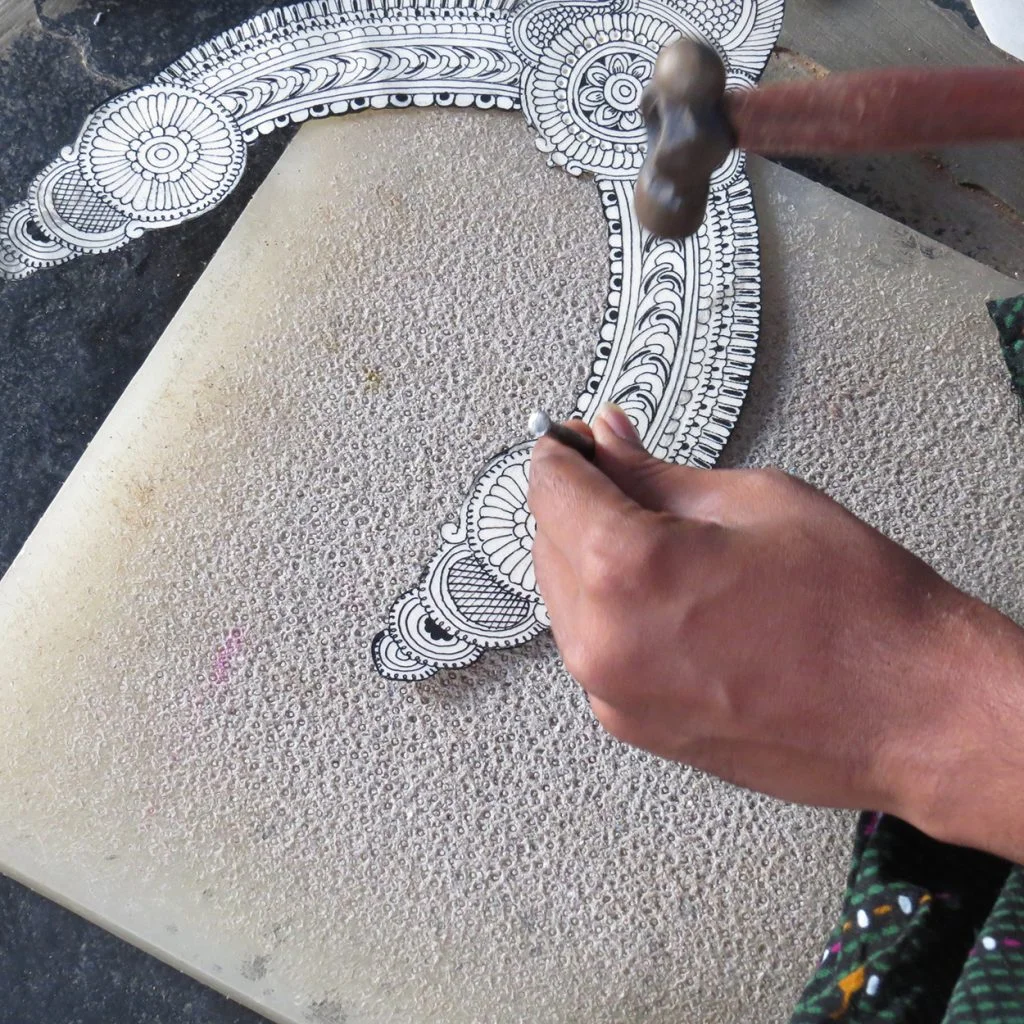
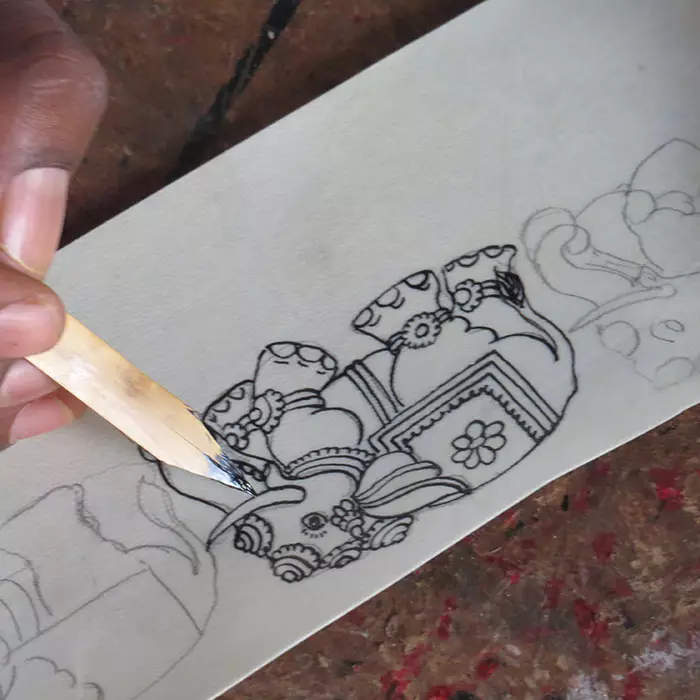
On my frequent travels to villages across the country, the one thing that strikes me is the influence of art and craft, nature and everything handmade in their everyday lives. From the use of the Neem stick to clean your teeth, to eating in crafted brassware, to playing hide and seek around their thatched roof homes, to women doing their daily chores in hand-woven Ikat saris. The influence of craft was so seamlessly part of them that they didn’t know any other way of life.
When I visited the leather puppet artists in Nilmalakunda, a small village in Anaanthapuram district of Andhra Pradesh, I was greeted by vibrant and colorful hide in different shapes and motifs decorating the entrance of almost every home. This craft has been handed down from generation to generation and the translucency and vivid colors, give the puppets their brilliance that they almost look like glowing jewels when viewed against light. Each layer of color gave a different shade and it was interesting to see a piece of art take shape in front of my eyes.
Allu Kullayappa and his son Khandey Kullayappa tell me about the “good old days” when they went from one village to the other on a bullock cart performing tales from the Mahabharata and Ramayana. Khandey started off as early when he was 10, making puppets and then going on to become a senior story teller on the troops travels across the country and even to France, about 7 years ago. “Till about 20 years ago, there were a lot of takers for our craft in the country and we were constantly on the move, but today our grandsons make more of lamps and other objects, very few puppets.”
The history of leather puppetry in India, dates back to the twelfth century. There are not too many written records of shadow puppets, even though India has a varied tradition of these. Historically, the tradition of Chhaya Natak (shadow theatre) seemed to have existed in Gujarat a thousand years ago and migrated to Maharashtra.
The traditional shadow puppet theater is mostly in the States of Karnataka, Andhra Pradesh, Kerala, Tamil Nadu, Maharashtra and Orissa. Even though the idea behind the puppetry shows were similar and they were based on stories from Ramayana and Mahabharata, there are interesting differences between the puppets from state to state.

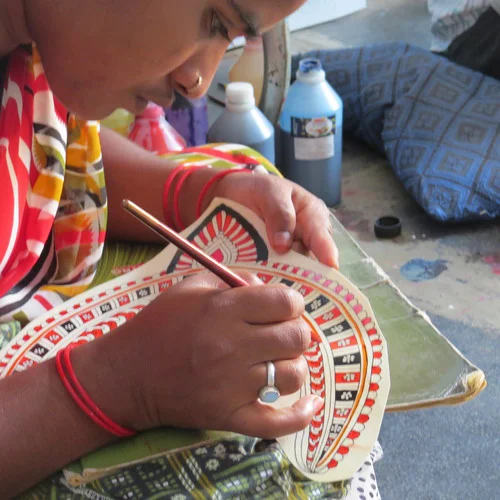
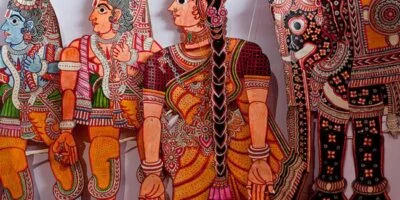
Andhra Pradesh- Tolubommalattam.Life size puppets.Their entire bodies can be manipulated and are very vibrant and colourful. They mostly have one eye.

Karnataka- Thogalugobeatta. Most of these puppets have two eyes, elaborately painted and cut outs around the iris. They are multicolored and life size. There are only couple of families who make them, almost extinct.
Kerala- Tolpavakoothu. The puppets are traditionally an extension of the human body and placed on a platform for performance. The hands and legs of these puppets are immovable as they perform the Ramayana and its inauspicious for deities to move their hands and legs according to Kerala traditions. They are painted in dark colours with more cut work and punching but less detailing.
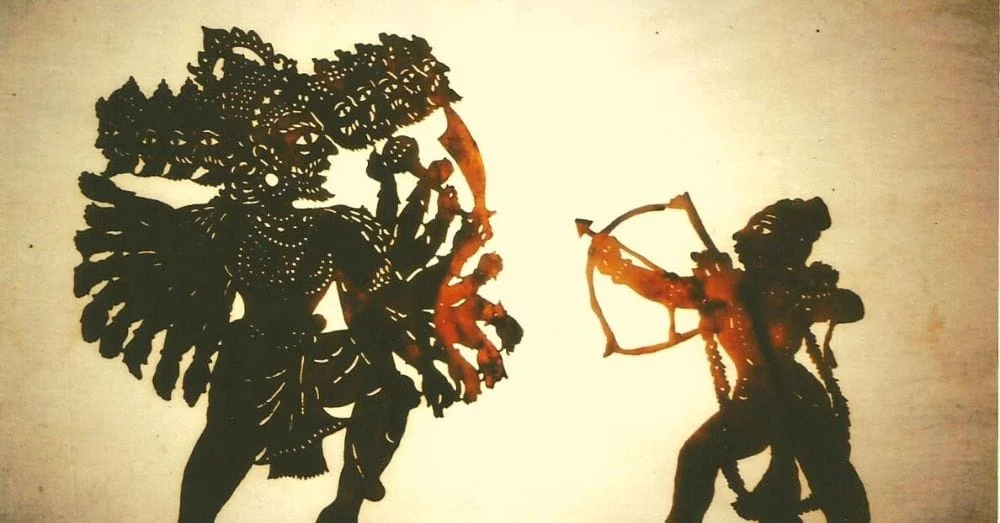
Maharashtra- Chamdyacha Bahulye. Dark coloured puppets with lot of punching and less painted detailing. These puppets are sadly on the verge of extinction. Orissa- Ravanchhaya. The puppets have no joints and are similar to the Kerala puppets in size and functioning. They come in dark colours with lot of punching.

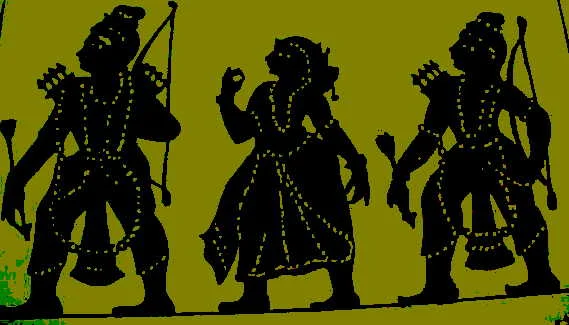
Comments (5)
Comment:
Who needs modern tech when you have centuries-old leather puppetry, right? Those vibrant Andhra Pradesh puppets look like theyre ready for a reality TV show – Glow Up with a Glove! Its fascinating how Tolubommalattam brings the Mahabharata to life, but I bet their grandsons prefer the steady income from lamps. The variety is staggering, from the detailed eye-cuts of Karnatakas Thogalugobeatta to the static stars of Keralas Tolpavakoothu – poor deities cant even wave hello! Maharashtras Chamdyacha Bahulye are *almost* extinct, perhaps because they lack the punchline. Overall, its a colorful tale of tradition, but I wonder if their bullock cart schedule got disrupted by Zoom calls. Long live the leather legends!アイム ノット ヒューマン
What a delightful read about the whimsical world of leather puppets! Who knew such vibrant, one-eyed charmers could hold such ancient tales? Its fascinating how these glowing jewels of artistry are now mostly making lamps instead of roaring tales from the Mahabharata. I do hope their grandsons find the lamp business as enchanting as their ancestors found storytelling, even if it means fewer bullock cart adventures across the country! Those poor Maharashtra puppets, almost extinct with lot of punching and less painted detailing – maybe they need a makeover? Either way, its a colorful tradition worth preserving before they all become antique lamps gathering dust!basketball stars io
What a splendid peek into the good old days of storytelling! Its a shame that now, instead of captivating audiences far and wide, the grandsons are busy with lamps. The vibrant, eye-catching puppets sound like theyd steal the show, almost glowing like jewels – brighter than some modern entertainment, surely! While the detailed descriptions of each states unique style are fascinating, I cant help but wonder if their grandsons will ever get the chance to travel to France again, perhaps showing off their lamp-making skills instead. The rich history of these shadow plays seems almost as endangered as the families who practice them. Long live the puppets, even if their travels are quieter now!deltarune final prophecy
What a fascinating glimpse into the good old days of leather puppetry! Its quite the trip down memory lane, literally, with Allu Kullayappa and Khandey Kullayappa reminding us how they constantly on the move like modern-day traveling salesmen on a bullock cart. I love that the puppets themselves are like glowing jewels, though I bet the grandsons prefer the easier sell of lamps these days! Who wouldnt rather make lamps than argue about the Mahabharatas plot for hours? The sheer variety is impressive, from the eye-catchers of Andhra Pradesh to the almost-extinct families in Karnataka and Maharashtra. Its a colorful, albeit slightly inauspicious, world of puppetry! A truly vibrant and colorful read.
What a colorful read! Those puppets almost glow like jewels – if they arent already hiding in someones lampshade, of course! Its amusing to hear the grand old days of bullock cart tours across the nation, now sounding like a quaint memory from a bygone era, perhaps best preserved in shadow puppet form. The state-by-state descriptions are fascinating, like a treasure map for puppet enthusiasts, though I do hope the families making these vibrant creations find more than just shadowy appreciation these days! Long live the colorful, jointed (or not!) storytelling!spin the wheel